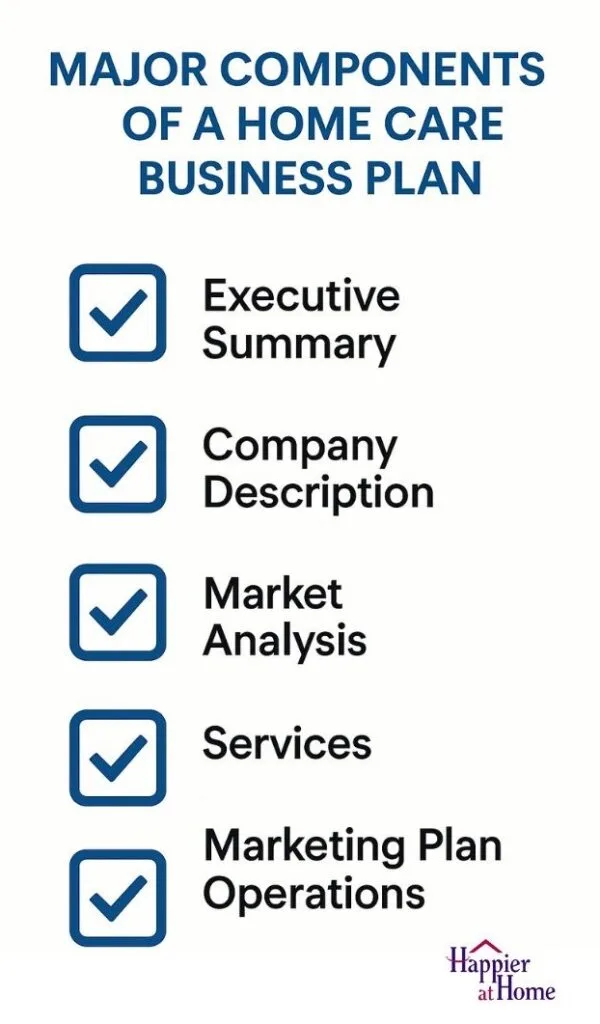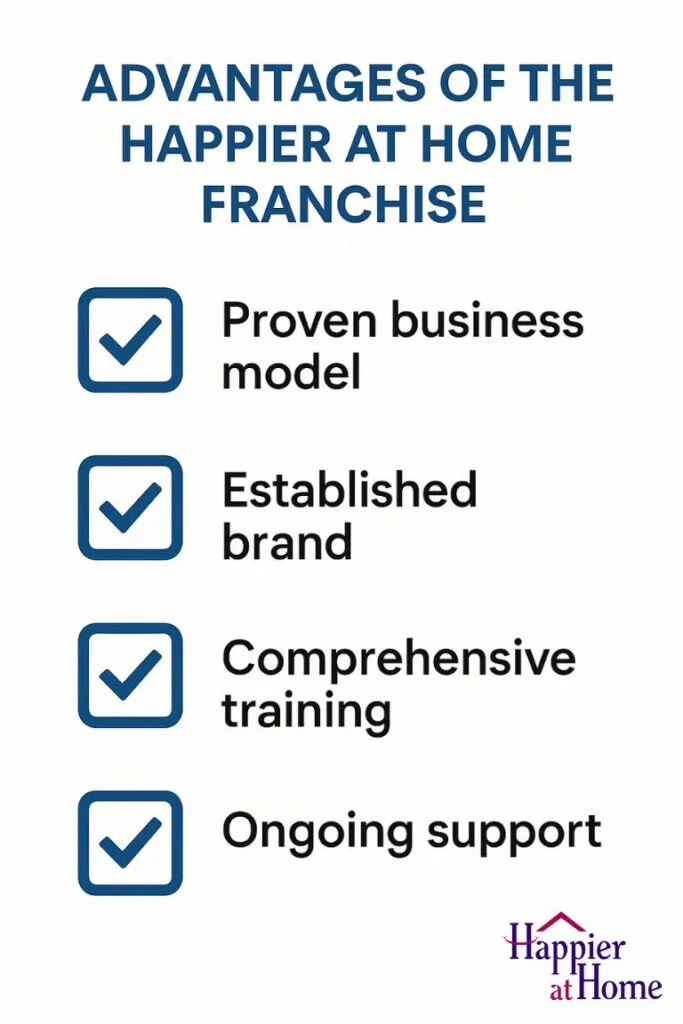The Ultimate Home Care Business Plan
Senior home care is in high demand. And there is a shortage of service providers throughout the United States. Starting a home care business is a great opportunity for compassionate entrepreneurs.
Yet there are many considerations to ensure success like licensing requirements, service offerings, employee logistics and protocols, logos, website, marketing and so on. In short, you need a good home care business plan.
Home care entrepreneurs have two choices: create a business plan for a home care agency from scratch or buy into an established home care franchise which provides a full blueprint for success and ongoing support.
Why a Home Care Business Plan Matters
A well-written home care business plan is more than a formality. It’s your roadmap for building a profitable and trusted care agency. The home care industry is highly competitive, regulated, and dependent on strong relationships with families and caregivers. Without a clear plan, it’s easy to make costly mistakes such as underpricing services, mismanaging staff, or failing to meet licensing rules.
A thoughtful plan outlines every part of your operation, from the legal setup and marketing strategy to staffing models and financial projections. It also proves to potential investors, lenders, or partners that you understand the industry and have a sustainable growth model.
Components Of A Business Plan For Home Care Agency
Step 1: Define Your Mission and Vision
Every successful business plan for a home care agency begins with a mission statement. This short paragraph explains your purpose, who you serve, and what makes your care philosophy unique. For example:
“Our mission is to help seniors maintain independence and dignity in their own homes by providing reliable, compassionate non-medical care.”
Your vision statement can be more aspirational. It might describe where you want your agency to be in five years—perhaps expanding into multiple cities or becoming known for exceptional client satisfaction. Together, these statements set the emotional tone for your business and guide all future decisions.
Step 2: Identify Your Target Market
A strong home care services business plan clearly defines the types of clients you intend to serve. This might include seniors living alone, families caring for aging parents, adults with disabilities, or post-surgery patients who need temporary help.
Analyze your local demographics. How many seniors live within a 25-mile radius? What’s the average household income? Which hospitals, senior centers, or retirement communities operate nearby?
Knowing your audience helps you tailor your pricing, marketing, and service menu. For instance, a suburban area with high-income households might support premium concierge care, while a rural community could need affordable hourly options.
Step 3: Choose Your Services
Your non medical home care business plan should outline every service you’ll provide. Non-medical care focuses on assistance with daily living rather than medical treatments. Common services include:
- Companion care services and social engagement
- Meal planning and light cooking
- Medication reminders
- Light housekeeping and laundry
- Transportation to appointments
- Personal care support such as dressing or bathing assistance
- Respite care for family caregivers
Be clear about your scope of services and the skill level required for each. Document how you’ll train caregivers and ensure quality control. If you intend to add specialized programs—like dementia care, veteran support, or mobility assistance—note how those will be delivered.
Step 4: Review Licensing and Legal Requirements
Each state has specific rules for home care agencies. Your home care business plan should include a section summarizing the legal framework in your state. You may need to register your business, apply for a state home care license, obtain insurance, and meet local health and safety standards.
Some states differentiate between medical and non-medical care. Be sure your services align with the proper license type. This part of the plan should also cover:
- Business structure (LLC, corporation, or sole proprietorship)
- Required permits and bonding
- Liability insurance coverage
- Background checks and caregiver screening
- HIPAA compliance for client information
A clear compliance section builds credibility with lenders, partners, and clients.
Step 5: Build a Staffing and Operations Plan
People are the heart of your home care agency. The business plan for a home care agency must detail how you’ll recruit, train, and retain reliable caregivers. This includes:
- Hiring criteria (experience, certifications, personality traits)
- Training programs and ongoing education
- Scheduling systems to match clients with caregivers
- Performance reviews and communication protocols
- Payroll structure, including hourly rates and overtime policies
Also describe your administrative roles—such as client coordinators, schedulers, and managers—and how you’ll handle after-hours support. A well-organized staffing plan ensures consistent service quality and minimizes burnout among caregivers.
Step 6: Develop Your Marketing and Sales Strategy
Even the best care agency can’t succeed without visibility. Your home care services business plan should outline a practical marketing strategy that connects your brand with families in need. Include both online and offline efforts such as:
- Local SEO for “home care agency near me” searches
- A professional website showcasing services, reviews, and contact forms
- Google Business Profile and social media accounts
- Partnerships with hospitals, rehabilitation centers, and senior communities
- Community events, sponsorships, and caregiver fairs
- Referral programs and testimonials
Remember that trust drives the home care industry. Use authentic stories, client testimonials, and caregiver spotlights to show empathy and reliability.
Step 7: Create Financial Projections
Your home care business plan should include detailed financial forecasts. This section demonstrates that you understand your costs and can achieve profitability. Key elements include:
- Startup expenses (licenses, insurance, office equipment, website, marketing)
- Ongoing costs (payroll, rent, software, supplies)
- Pricing structure (hourly rates and service packages)
- Projected revenue and break-even analysis
- Cash flow and profitability over the first three years
Use realistic numbers. It’s better to slightly underestimate revenue than to overpromise. Investors and lenders will take your plan more seriously when projections are conservative and data-driven.
Step 8: Plan for Growth and Sustainability
A solid home care services business plan looks beyond launch day. Include strategies for expansion, such as opening additional territories or offering new programs like transportation or live-in care.
Also outline quality assurance systems to ensure consistent service delivery. These may include client surveys, random home visits, or digital care logs.
Finally, plan how you’ll keep your caregivers motivated through recognition, training, and career development. Retention reduces recruitment costs and strengthens client relationships.
Step 9: Understand the Challenges
Starting a non-medical home care agency from scratch may sound appealing, but it’s not without hurdles. Entrepreneurs face numerous challenges:
- Navigating complex licensing procedures
- Establishing a trusted reputation with zero track record
- Competing with established franchises and local providers
- Creating staff manuals, policies, and procedures from scratch
- Designing marketing materials, websites, and logos
- Managing cash flow during the first year of low client volume
Resources For a Home Care Services Business Plan
Here are four resources tailored for entrepreneurs looking to build a strong foundation for a non-medical home care agency. These come from government or nonprofit organizations that offer training, templates, counseling, and funding pathways.
| Resource | What it offers | Link |
|---|---|---|
| U.S. Small Business Administration — Write Your Business Plan | Step-by-step guidance and templates for each section of your plan. | sba.gov/business-plan |
| SBA — Women’s Business Centers (WBCs) | Local training, mentoring, and planning support focused on women entrepreneurs. | Find a WBC |
| SBA — Office of Women’s Business Ownership (OWBO) | Programs and tools for women-owned firms, including training and access to capital. | About OWBO |
| SCORE — Free Mentoring & Workshops | One-on-one mentorship and classes to review and refine your plan. | Find a Mentor |
| CARE — Women’s Entrepreneurship Initiative | Training and tools that strengthen business models and growth plans for women-led ventures. | care.org initiative |
Each challenge consumes time, money, and energy—especially for those new to the healthcare field. That’s why many entrepreneurs choose to invest in a proven home care franchise model.
Buying a Home Care Franchise Can Be the Smarter Move
Buying into an established brand gives you a head start. A senior care franchise system provides training, operational support, marketing materials, and a trusted name that families already recognize. Instead of building everything alone, you begin with a working model that has already proven successful in multiple markets.
Franchise owners still operate independently, but they benefit from national marketing, lead generation, and ongoing mentorship. This structure reduces the risk of early mistakes and increases your chance of long-term profitability.
Among today’s franchise options, Happier At Home stands out as a leader in personalized non-medical care for seniors and adults. The company has years of experience refining its model to help owners grow faster and serve clients better.
Here are key advantages of joining this franchise rather than writing your own home care business plan from scratch:
1. Proven Business Model
Happier At Home gives you a complete home care services business plan ready to implement. You don’t have to reinvent client forms, service descriptions, caregiver policies, or marketing templates—they’re already created and tested.
2. Training and Support
New franchise owners receive hands-on guidance covering operations, licensing, caregiver training, and marketing. You gain access to an experienced team that helps you avoid common pitfalls during startup and growth.
3. Recognized Brand and Trust
Families seeking care often prefer known names. Happier At Home has built a positive national reputation that helps new owners attract clients faster than an unknown local startup.
4. Streamlined Marketing System
The franchise provides branded materials, websites, and search-optimized marketing tools to help you capture leads online. This saves thousands of dollars and months of trial and error in building your own campaigns.
5. Technology and Tools
You’ll receive proprietary software for scheduling, caregiver management, and client tracking. These systems simplify administration so you can focus on quality care and growth.
6. Collaborative Network
Owning a franchise means joining a community of like-minded business owners. You can share experiences, learn from others’ successes, and receive ongoing updates on best practices.
7. Scalable Growth Opportunities
Happier At Home franchisees can expand into multiple territories or add complementary services over time. The corporate team supports growth planning, ensuring your operation scales sustainably.
How to Get Started with Happier At Home
Launching your own home care business under the Happier At Home banner begins with a discovery call. You’ll learn about available territories, investment costs, and training programs. Once approved, the onboarding process walks you step-by-step through licensing, hiring, and marketing.
Within months, many franchisees start serving clients and building their reputation in the community. The ongoing support structure means you’re never alone. Help is always a phone call away.
Choose a Path to Proven Success
Creating a business plan for a home care agency is essential to success. But doing it from scratch requires time, research, and a deep understanding of regulations and operations. While independent ownership can work, it often takes years to reach the stability that a proven franchise model achieves quickly.
By investing in a reputable franchise like Happier At Home, you gain immediate access to a trusted brand, streamlined systems, and expert guidance. This approach allows you to focus on what matters most—helping seniors live safely and comfortably at home—while building a profitable, sustainable business.
If your goal is to make a difference in your community and enjoy a rewarding career in senior care, start with a strong foundation. A comprehensive home care business plan paired with the proven Happier At Home franchise system is the smartest way to turn your compassion into success.



